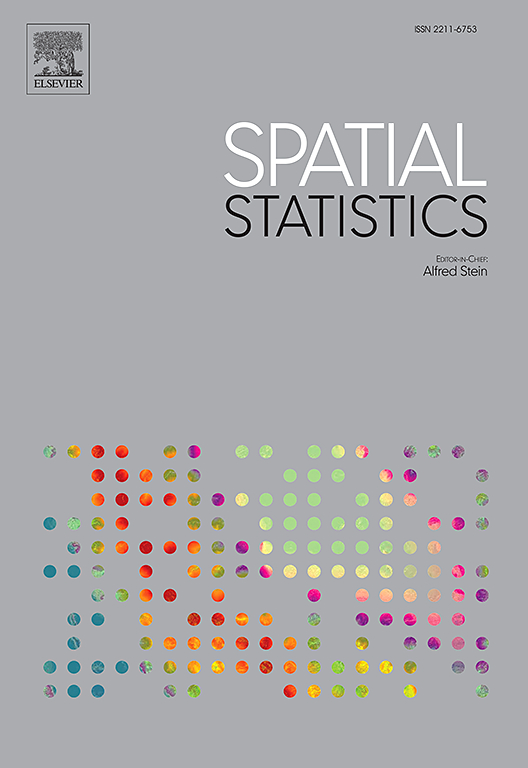基于对数对称模型的斑点杂波规则网格空间处理方法
IF 2.5
2区 数学
Q3 GEOSCIENCES, MULTIDISCIPLINARY
引用次数: 0
摘要
在环境和气候动力学方面,解决遥感(RS)问题对社会至关重要,仅举几个例子。一种有效的遥感源是利用合成孔径雷达(SAR)通过图像描述自然和人为现象。我们的方法是将SAR图像背后的数据理解为随机变量的结果,然后使用统计学来解决RS问题。在本文中,我们将SAR图像的输入视为正则空间中的随机变量,并使用二维LOGSYM自回归移动平均(2d LOGSYMARMA)模型的新提议来描述SAR强度的性质(受散斑噪声影响并阻止直接解释的严格正非对称特征)。除了讨论所提出的模型与SAR强度之间的物理关系(提到它可以扩展常用的对数正态律)外,我们还推导了二维LOGSYMARMA的一些数学性质:基于矩阵的分数函数和Fisher信息。详细讨论了二维LOGSYMARMA参数的条件最大似然估计(CML)。我们进行了蒙特卡罗研究,以量化结果估计的性能,并验证了CML估计器所期望的渐近行为是实现的。最后,我们对真实的SAR数据进行了应用,其中我们的建议应用于不同类型的区域-海洋,森林和城市地区-利用对数对称族的多功能性。人工实验和实际实验结果表明,该模型是SAR图像空间信息提取和分类的重要工具。本文章由计算机程序翻译,如有差异,请以英文原文为准。

A new regular grid-based spatial process on the log-symmetric model for speckled clutter
Solving remote sensing (RS) problems is crucial for society when it comes to environmental and climate dynamics, to name just a few examples. An efficient RS source is the use of synthetic aperture radar (SAR) to describe natural and man-made phenomena through imagery. Our approach is to understand the data behind SAR images as outcomes of random variables, and then use statistics to solve RS problems. In this paper, we consider the input of a SAR image as a random variable in regular space and describe the nature of SAR intensity (a strictly positive and asymmetric feature that is affected by speckle noise and prevents direct interpretation) using a new proposal for a log-symmetric (LOGSYM) regression model in two dimensions, the 2-D LOGSYM autoregressive moving-average (2-D LOGSYMARMA) model. Besides a discussion on the physical relationship between the proposed model and SAR intensity (mentioning that it can extend a commonly used lognormal law), we derive some mathematical properties of 2-D LOGSYMARMA: matrix-based score function and Fisher information. We discuss in detail the conditional maximum likelihood (CML) estimation for the 2-D LOGSYMARMA parameters. We conduct a Monte Carlo study to quantify the performance of the resulting estimates and to verify that the asymptotic behavior expected from CML estimators is achieved. Finally, we perform an application to real SAR data, where our proposal is applied to different types of regions – ocean, forest, and urban areas – utilizing the versatility of the log-symmetric family. Results of both artificial and real experiments show that our model is an important tool for the extraction and classification of spatial information in SAR images.
求助全文
通过发布文献求助,成功后即可免费获取论文全文。
去求助
来源期刊

Spatial Statistics
GEOSCIENCES, MULTIDISCIPLINARY-MATHEMATICS, INTERDISCIPLINARY APPLICATIONS
CiteScore
4.00
自引率
21.70%
发文量
89
审稿时长
55 days
期刊介绍:
Spatial Statistics publishes articles on the theory and application of spatial and spatio-temporal statistics. It favours manuscripts that present theory generated by new applications, or in which new theory is applied to an important practical case. A purely theoretical study will only rarely be accepted. Pure case studies without methodological development are not acceptable for publication.
Spatial statistics concerns the quantitative analysis of spatial and spatio-temporal data, including their statistical dependencies, accuracy and uncertainties. Methodology for spatial statistics is typically found in probability theory, stochastic modelling and mathematical statistics as well as in information science. Spatial statistics is used in mapping, assessing spatial data quality, sampling design optimisation, modelling of dependence structures, and drawing of valid inference from a limited set of spatio-temporal data.
 求助内容:
求助内容: 应助结果提醒方式:
应助结果提醒方式:


